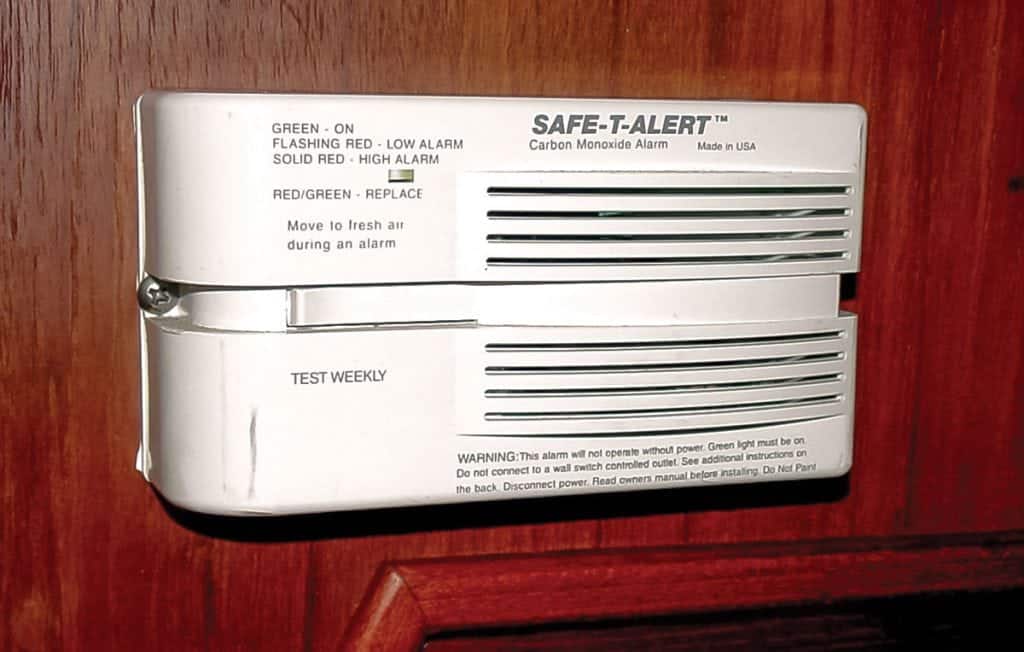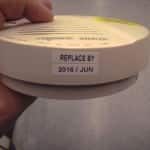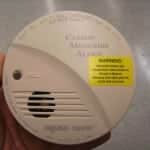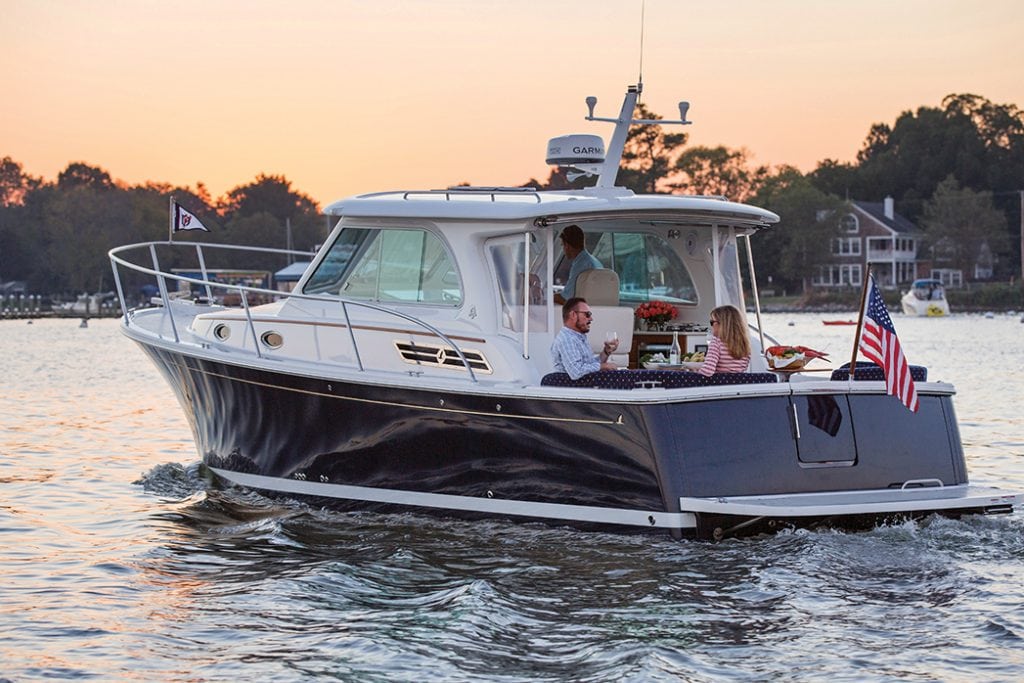You see them in pretty much every land-based facility—those innocuous little sentinels that warn us of fire and carbon monoxide (CO). The good news for mariners is that their umbrella of protection doesn’t have to end at the water’s edge. Here’s why carbon monoxide detectors are essential for protecting you and your onboard guests.
CO is a potentially lethal gas produced when burning any carbon-based fuel (gasoline, diesel, propane, wood, etc.). While the most common source of CO is exhaust from gasoline or diesel engines, any open flame device such as a stove, heater or grill can produce it. Common signs of CO poisoning include headaches, dizziness, weakness, drowsiness, headache, and nausea—symptoms that can all too easily be attributed to seasickness, alcohol, or too much sun exposure rather than CO poisoning. Although death can occur quickly in a CO-rich environment, exposure to smaller amounts can be just as lethal. The effects of CO are cumulative and can build up gradually in a person’s bloodstream for hours or even days before reaching critical levels. How quickly this occurs is dependent on the concentration of CO being inhaled (measured in parts per million [PPM]) and the duration of exposure.
Unlike the smoke generated by a fire, carbon monoxide is colorless, tasteless and odorless, so the only reliable way to guard against it is the installation of a CO detector. The American Boat & Yacht Council (ABYC) Standard A-24 recommends the installation of carbon monoxide (CO) detectors for all boats utilizing inboard gasoline-powered engines or generators and featuring an enclosed accommodation compartment—defined as a contiguous space containing sleeping accommodations, galley area with sink and a head compartment. ABYC exempts diesel engines from this requirement and while it’s true they produce less CO than gasoline engines, my personal recommendation is that detectors be installed aboard both gasoline and diesel-powered vessels.
The National Fire Protection Association (NFPA) 302 calls for vessels 26 feet or more in length with accommodation spaces intended for sleeping to be equipped with a single-station smoke alarm listed to UL 217 (Standard for Single and Multiple Station Smoke Alarms) and suitable for use in recreational vehicles. ABYC requires that CO detectors be tested to UL 2034 standards.
CO can easily be generated by other sources on board or even introduced from nearby boats via the ventilation system. If you utilize a generator to power air conditioners and other appliances while at anchor, an even better option would be a CO alarm system designed to shut off the generator once CO is detected, such as those offered by Fireboy-Xintex (fireboy-xintex.com) or MariTech Industries (powerboatsafety.com).
Smoke and CO detectors can be purchased individually or as combination units. Another option to the traditional single unit smoke detector is Fireboy-Xintex’s FR Series Fire Detection Systems. The FR Series consists of a monitor panel that supports up to 14 remote smoke or heat detectors for a 12VDC system, or 8 detectors on a 24VDC system. Depending on the model, the FR systems support 1, 2, 4, 8, or 16 zones plus up to 2 audible alarms per zone.
The first impulse for many boat owners is to purchase residential-type units, but be aware that some may not meet construction requirements for marine-grade units (such as Underwriters Laboratories standard 1524).
CO and smoke detectors can be either battery powered (the 9-volt type) or hardwired to a vessel’s DC system. The obvious benefit of battery-powered units is that they can be installed almost anywhere without the need for wiring; however, this lack of an external power supply can also be a disadvantage from a reliability standpoint.
Like their land-based counterparts, battery-powered marine detectors “chirp” to warn users when their internal battery is low. Unlike a typical land-based home or office, boats may go weeks or even months without use. As such, even if the unit chirps for weeks before dying, it’s possible no one will be around to hear it. The best policy here is to self-test the unit weekly and replace the batteries regularly as per the manufacturer. It’s important to note that in the past, CO detectors gained a bad reputation for generating numerous false alarms. Older “single point” alarms began shrieking at the slightest hint of CO, which could be unnerving as a whiff or two of CO commonly drifts into the cabin periodically throughout the day. Modern units use “time-weighted averaging” to determine the amount of CO present over a period of a few minutes rather than at one point in time, greatly reducing the number of false alarms.
Hardwired marine units are powered by the vessel’s 12- or 24-volt DC power system. Those designed for residential or commercial installations (should you still be tempted) utilize 120VAC, which may not always be available while cruising. Power for hardwired detectors must be provided (via an appropriate fuse or circuit breaker) from the “hot” side of the battery switch to prevent them from being accidentally shut off.
Neither ABYC or NFPA states specifically where CO or smoke detectors should be located on your vessel, however they do provide some general guidelines. Primarily, they must be located to monitor the atmosphere in the main cabin and each sleeping area.
Choose a location that both protects the detector from physical damage (rain, spray, sunlight, etc.) and avoids what ABYC calls “dilution of sampled air,” which could occur near hatches, ports, or forced ventilation openings. Locations containing “dead air” spaces should also be avoided to prevent distorted readings.
Unlike LPG or gasoline vapors, which are heavier than air, CO has roughly the same weight as oxygen meaning detector placement is not limited to high or low areas of the cabin. As such, choose a location that is roughly eye level, which makes it easier to monitor detector meters or warning lights.
Finally, both CO and smoke detectors have a limited lifespan. Detectors or sensors (if part of a system) typically need to be replaced every five years, however this varies between units. Check with the manufacturer and verify the recommended replacement intervals prior to purchase and installation.
The following general safety recommendations concerning the dangers of carbon monoxide apply to all vessels and in particular to houseboats and/or similarly constructed vessels:
1. Stay out of areas where carbon monoxide can collect while the engine or generator is running and for at least an hour afterwards. The Coast Guard advises owners and operators of boats to turn off generators with transom exhaust ports when the swim platform on the stern is in use.
2. Don’t allow swimmers near exhaust portals or areas where air pockets may be located under the boat. Swimmers should avoid the area beneath transom swimming platforms or rear decks while the engine or generator is running; if exhaust vents are located on the vessel’s side, these areas should be avoided as well. Adults should keep a close watch on children at all times, particularly when they are playing or swimming in the swim platform area. As a general rule, passengers or crew should not be allowed to sit on swim platforms while the vessel’s engine(s) or generator is running.
3. Use caution when boats are tied together, as carbon monoxide generated in one vessel can enter other nearby vessels via air conditioning intakes, open portholes, etc.
4. Know the signs of carbon monoxide poisoning and if suspected, relocate the victim to an area of fresh air and seek medical attention immediately.
5. Read and obey all carbon monoxide warnings placed on generators and engines by the manufacturer, and never tamper with or disconnect carbon monoxide detectors or monitors.
6. Turn off generators prior to going to sleep AND turn off the main AC breaker so “demand start” generators will not start during the night.
By Frank Lanier, Southern Boating June, 2015
















